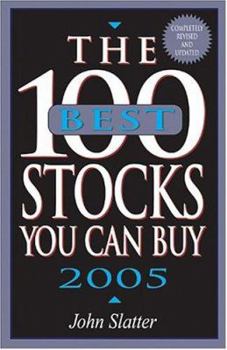100 Best Stocks (2005)
In The 100 Best Stocks You Can Buy, 2005, the author, a professional investment buyer, has analyzed and evaluated thousands of individual stocks to help readers readjust to the economic climate in... This description may be from another edition of this product.
Format:Paperback
Language:English
ISBN:1593371020
ISBN13:9781593371029
Release Date:September 2004
Publisher:Adams Media Corporation
Length:365 Pages
Weight:1.05 lbs.
Dimensions:1.0" x 6.1" x 9.3"
Customer Reviews
2 ratings
Great place to start looking for stocks
Published by Thriftbooks.com User , 18 years ago
This is a great place to start if you are looking for stocks to buy. It gives a great breakdown of a stocks 8 year history of: >Revenue <br />>Net Income <br />>Earnings per share <br />>Dividends per Share <br />>Highest and Lowest stock price for each year <br />It gives you the basic profile of the company,the shortcomings to bear in mind,and reasons to buy. <br />It is great for ideas on companies to buy with a great overview of the stocks history. It divides stocks into its industry, sector, and category. This book will be useful to use to understand and create a diversified portfolio of individual stocks. <br />But be warned of three things: <br />1). Use this book as a history book not a newspaper, go to Quotes/Yahoo or marketcenter.com for up to date information. <br />2). These are all large cap stocks, this book is not for investors looking for small cap stocks. <br />3)/ This is a basic beginners book, great for them, but an experienced investor will already have this information from other periodicals. <br /> <br /> <br />
Excellent book on the great companies
Published by Thriftbooks.com User , 20 years ago
I read and liked Mr. Slatter's previous 2004 version of this book, so I picked up this one too. Each company is described in great detail, so you get a good idea of their business, the products they make or services they provide, how they operate, management's approach to business, and their record of past earnings and dividends. There are many familiar names here, such as Johnson and Johnson, Proctor and Gamble, Walmart, General Mills, Coca-Cola, Merck, IBM, Medtronic, but also many other companies that you may not have heard of that have been around for decades and have consistently been profitable or increased earnings or dividends over time, such as Illinois Tool Works, which has been around since 1912, has paid a dividend since the 1930s, and during the decade 1993 to 2003, earnings went from .92 to $3.37, a compound annual growth rate of 13.9 percent, and dividends went from .25 to .94, for a growth rate of 14.2 percent. Besides detailed profiles of all the companies, there are also sections on The Essentials of Successful Investing, Some Thoughts on Analyzing Stocks, How To Avoid Portfolio Blunders, 21 Ways to Reduce Investment Risk, What's Wrong with Buying Mutual Funds?, A Novel Approach to Asset Allocation, How to Get Started, The Pros and Cons of Dollar Cost Averaging, Basic Terminology, and How My 100 Stocks Were Selected. For example, Mr. Slatter points out the importance of diversification, picking stocks that have a history of a rising trend of earnings, that have a return on equity of 15 or better (an excellent way to immediately gauge the historical and overall performance of a stock), the use of dollar cost averaging, asset allocation, and many other useful topics. One thing that may surprise many readers is Mr. Slatter isn't a fan of mutual funds. Ninety percent of mutual funds underperform the market. This usually isn't because of poor stock picking by the management, but because of several other reasons: mutual fund fees and expenses can be as high as 3 percent, mutual fund expense ratios reached a high of 1.6 percent in 2002, and stock turnover costs are about 0.8 percent. These expenses are enough to cause most mutual funds to perform below the market. Futhermore, picking a mutual fund isn't that easy anymore. As of the late 90s, there were over 5000 mutual funds, more than there are stocks on the New York Stock exchange, all of which have various approaches and different levels of risks. For these reasons, Slatter isn't a big fan of mutual funds and instead favors putting together a portfolio of high quality stocks yourself. And by distributing them throughout all the different industries and sectors, from high tech to retail, you can achieve sufficient diversification without having to own a mutual fund. Interestingly, the economist who developed the modern theory of stock diversification (and who won the Nobel Prize in Economics for this contribution) showed that picking only one or two of the top companies from e






